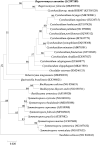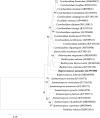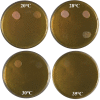Begerowomyces aurantius sp. nov., a novel yeast isolated from koalas' habitat in a Japanese zoological park
- PMID: 36653148
- PMCID: PMC10076191
- DOI: 10.1292/jvms.22-0374
Begerowomyces aurantius sp. nov., a novel yeast isolated from koalas' habitat in a Japanese zoological park
Abstract
Koalas are iconic mammals indigenous to Australia. These rare animals and their habitats are occasionally associated with pathogenic fungi, including species of Cryptococcus, and consequently, monitoring the mycobiota of areas inhabited by koalas is of considerable importance. In this report, we describe a novel basidiomycetous yeast isolated from a site in Kanazawa Zoo, Japan, associated with captive koalas. Swab samples were collected from koala breeding environments, from which we isolated a novel unencapsulated yeast characterized by ovoid to ellipsoidal cells (3.2-4.9 × 3.5-5 μm). These cells were observed to undergo polar budding and grow as parent bud pairs, with an optimal growth temperature of 28°C. Colonies grown on yeast extract peptone dextrose agar at 28°C have a characteristic coral pink color. On the basis of physiological, morphological, and molecular characters, the new species was placed in the genus Begerowomyces, and the name Begerowomyces aurantius JCM33898T(LSEM1333T=CBS16241T) is proposed.
Keywords: Begerowomyces; breeding environment; koala; novel yeast.
Conflict of interest statement
The authors declare no conflicts of interest.
Figures





Similar articles
-
Sporobolomyces koalae sp. nov., a basidiomycetous yeast isolated from nasal smears of Queensland koalas kept in a Japanese zoological park.Int J Syst Evol Microbiol. 2008 Dec;58(Pt 12):2983-6. doi: 10.1099/ijs.0.2008/000307-0. Int J Syst Evol Microbiol. 2008. PMID: 19060093
-
Cryptococcus lacticolor sp. nov. and Rhodotorula oligophaga sp. nov., novel yeasts isolated from the nasal smear microbiota of Queensland koalas kept in Japanese zoological parks.Antonie Van Leeuwenhoek. 2013 Jul;104(1):83-93. doi: 10.1007/s10482-013-9928-y. Epub 2013 May 8. Antonie Van Leeuwenhoek. 2013. PMID: 23653119
-
Cryptococcus yokohamensis sp. nov., a basidiomycetous yeast isolated from trees and a Queensland koala kept in a Japanese zoological park.Int J Syst Evol Microbiol. 2011 Dec;61(Pt 12):3068-3071. doi: 10.1099/ijs.0.027144-0. Epub 2011 Jan 21. Int J Syst Evol Microbiol. 2011. PMID: 21257688
-
Long-term surveillance and treatment of subclinical cryptococcosis and nasal colonization by Cryptococcus neoformans and C. gattii species complex in captive koalas (Phascolarctes cinereus).Med Mycol. 2012 Apr;50(3):291-8. doi: 10.3109/13693786.2011.594967. Epub 2011 Aug 23. Med Mycol. 2012. PMID: 21859391
-
Jet-Setting Koalas Spread Cryptococcus gattii VGII in Australia.mSphere. 2019 Jun 5;4(3):e00216-19. doi: 10.1128/mSphere.00216-19. mSphere. 2019. PMID: 31167945 Free PMC article.
References
-
- Alshahni MM, Makimura K, Yamada T, Satoh K, Ishihara Y, Takatori K, Sawada T. 2009. Direct colony PCR of several medically important fungi using Ampdirect plus. Jpn J Infect Dis 62: 164–167. - PubMed
MeSH terms
LinkOut - more resources
Full Text Sources
Research Materials

